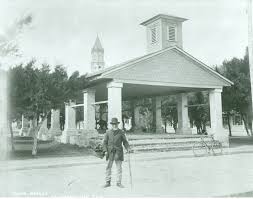
In early Jan 2019 we took a road trip to St Augustine, FL, the oldest city in the nation. The view from the shore is lovely, out across the bay and barrier islands to the Atlantic beyond. The bay is naturally secure with barrier islands that protect the mainland, where the Spanish built a fort that proved to be impenetrable to the enemies that followed.

Next to the bay there is a replica of a native village, which interestingly is organized into several “tiny houses” around a central meeting area. Each of the buildings, which are essentially round pole barns with thatched roofs and woven or thatched walls, was used for a different purpose, eating, sleeping, meeting, etc. Their diet was primarily fish and shellfish, which were abundant in the waters of the bay, and wild game from the forests. The natives ate a limited amount of berries and wild plants, but they were mainly hunter-gatherers. The culture was inter-generational. Children had their share of responsibilities from an early age. The elders were revered for their wisdom.
The history of this area is about Spanish exploration and conquest of the Timucuan natives in the 16th Century. Tour guides hint of tensions between the Spanish, and later English, explorers and the natives. At one point the Spanish are said to have moved their settlement to the barrier islands for safety; on another occasion the entire city was burned to the ground, in a decidedly unfriendly action that destroyed all the buildings and necessitated starting again. “Bother, those pesky natives!”

There is less said about the quality of life that the native Timucuans enjoyed, tall and robust with life expectancies of 80 – 100 years, than about the technologies that the Spanish brought guns, cannons, horses, agriculture, impenetrable forts, and a class system that, then as now, ensures 90% of the wealth and power to 10% of the population. Little is said about the diseases the Europeans brought. Life expectancies for a European male at that time were 37-40 years. No one mentions that those natives who did not die, or were not scripted into slavery, were exiled to Cuba and eventual extinction.

St. Augustine is home to Flagler College and a variety of churches and public and private buildings, all built in the ornate style of Spanish Revival and European Renaissance.
The Fountain of Youth is the major attraction and is one of twenty-plus stops on the hour long trolley ride that tours the city that Henry Flagler built. Hats off to the Spanish explorer Menendez, who figured out a way to monetize the natural springs that natives drank from for centuries. Tourists flock to the small adobe building that houses the site of the original spring, sipping to their good health from the little plastic cups that bear the legend “Made in China”. The Timucuan Chief would be proud.
Cheers,
Gus

